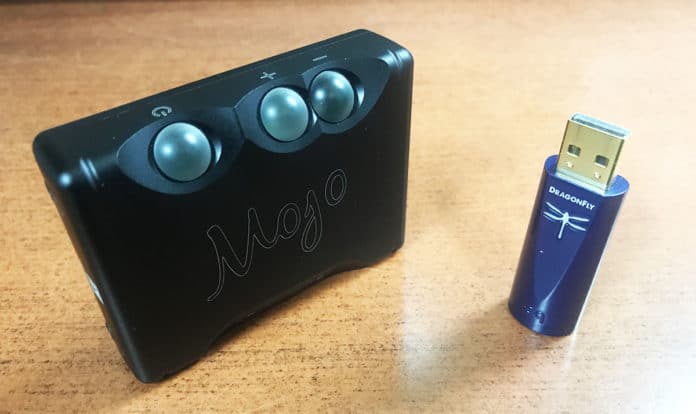The new release of the Audioquest Dragonfly Cobalt has many folks in the audiophile world curious about its skill. With so many upgrades in sound quality from the Dragonfly Red, folks are wondering how it compares to another heavy hitting portable DAC/amp, the infamous Chord Mojo! The Mojo, at a slightly higher price point, is one of the most highly regarded portable DAC/amps out there. But can the Cobalt compete with it? Let’s take a closer look with this Audioquest Dragonfly Cobalt vs Chord Mojo Comparison review.
Audioquest Dragonfly Cobalt vs Chord Mojo Comparison Review
In the Box
| Audioquest Dragonfly Cobalt | Chord Mojo |
|---|---|
| Dragonfly Cobalt DAC/amp | Chord Mojo DAC/amp |
| Leather protective case | Micro USB cable |
| Dragon Tail USB C | Documentation |
| Documentation |
Design
Look and Feel
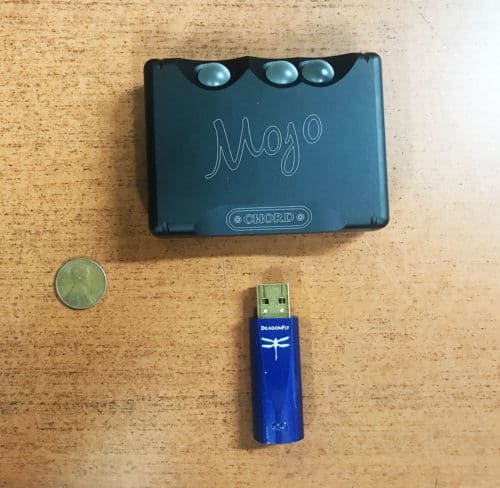
The Audioquest Dragonfly Cobalt and the Chord Mojo have very different looks from each other. On one hand, the Dragonfly Cobalt is remarkably small, sporting a sparkly blue finish and round edges. The Mojo has rounded edges too, but resembles a pack of cards in its size and shape. It’s matte black design looks mature and classy, whereas the Cobalt seems more playful. However, both sport colorful lights which correspond to the playback formats, and for the Mojo, to the volume level.
Both the Audioquest Dragonfly Cobalt and the Chord Mojo feel very durable with aluminum chassis and an overall sense of simplicity in their designs compared to other DAC/Amps in their price ranges. However, while the Cobalt has an extremely simple one-input-one-output design, the Mojo has more variability with three input options and two 3.5 mm outputs.
Features
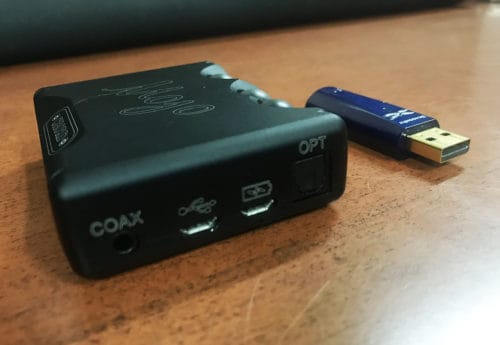
The Audioquest Dragonfly Cobalt and the Chord Mojo have a few major differences in their designs which will make them better or worse for different types of listeners. One on hand, the Cobalt draws power from the listening device, whereas the Mojo draws power from an internal battery which lasts for about 8 hours of playback. As a result, the Cobalt, due to its size and power situation, is going to be a better option for those prioritizing portability.
Additionally, the Audioquest Dragonfly Cobalt and the Chord Mojo have different DAC chips, which affect both their sound characteristics as well as the playback formats they support. On one hand, the Cobalt has a Sabre ESS ES9038W2M DAC chip. It can play back PCM with up to a 96 kHz sample rate. Additionally, it supports MQA playback. By comparison, the Mojo has a custom Chord FPGA DAC chip. It can play back DSD256 and PCM with up to a 768 kHZ sample rate.
Lastly, one big difference between the Audioquest Dragonfly Cobalt and the Chord Mojo is their output power. Audioquest says the Cobalt is made to work well for modernly efficient headphones. By contrast, the Mojo has a much greater output and Chord says it can power headphones with up to an 800 ohm impedance. As a result, the Mojo is going to be the best option for those who have a power hungry headphone.
Sound
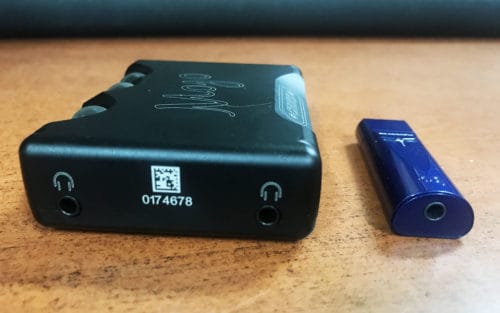
Comparison reviews between DAC/amps are challenging. Often times, the differences are slight, and have nuance, and require special attention to level matching. This sound comparison is no exception. Additionally, in an attempt to make the comparison as fair as possible, I listened with an efficient IEM, the Meze Rai Penta. I knew both DAC/amps could easily power it and I know the IEMs well. One disclaimer I’d like to make is that the nuance of these differences are small and nuanced and won’t be audible to some listeners. But for those with sensitive ears like me, this is what you’ll here:
Low Frequencies
The low frequencies of the Audioquest Dragonfly Cobalt and the Chord Mojo have punchy, clear low ends. They have a remarkably similar tonality and sense of depth. However, while the difference was admittedly subtle, the low end felt bouncier and slightly more accurate in pitch with the Chord Mojo.
For example, when I was listening to the song Formation by Beyonce, the bass synth seemed to have a clearer note than it did with the Cobalt. Additionally, the 808 moved with more groove and bounce with the Mojo. By contrast, with the Cobalt, the bass synth felt firm and strong, but had more of a sense of feeling than of key. Additionally, the 808 had punch and space, but felt slightly less energetic. I noticed it most obviously in the little quick ghost-type notes of the 808. Ultimately, this gave the Chord Mojo a step up over the Cobalt because it felt dancier and more emotionally impactful for the groove of the song.
Middle Frequencies
The middle frequencies of the Audioquest Dragonfly Cobalt and the Chord Mojo are clear and full, and have considerable spaciousness and detail. However, the midranges feel a bit different from each other in their overall aesthetic presentations. On one hand, the Cobalt seems to push forward the high-mids. This emphasis brings out the specificity of textures and brings vocals forward in space. By contrast, the Chord Mojo has an aesthetically pleasing harmonic richness which helps to give the high-mids a smoother feel. And while it maintains detail and texture, it was a little bit easier to listen to. Vocals sit more evenly in the mix with the Mojo.
For example, when I was listening to the song No Dad by Taylor Hollingsworth, the crunchiness of the electric guitar had textural emphasis with the Audioquest Dragonfly Cobalt. Additionally, Taylor’s voice sat forward along with that textured crunch. This provided a great sense of detail, but was slightly more fatiguing to the ears than with the Mojo. By contrast, the Chord Mojo the vocal felt more evenly balanced with the crunch of the electric guitar. There was an underlying smoothness where the crunch sat, and while it still felt textural, a sense of harmonic richness helped to smooth the pointiness it seemed to have with the Cobalt.
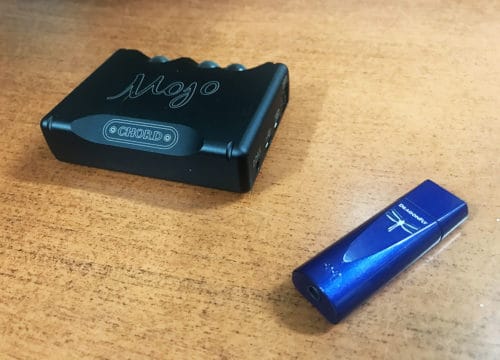
High Frequencies
The high frequencies of the Audioquest Dragonfly Cobalt and the Chord Mojo have spaciousness and detail. However, similar to the midrange, the overall presentation of the highs is slightly different from one another. On one hand, the Dragonfly Cobalt feels a little bit more forward in the lower treble. This forwardness provides detail, but also makes that area of the frequency spectrum a little bit less spacious sounding, and ultimately a little bit less smooth in comparison to the Mojo. There is a pointiness to the Cobalt that brings out details in the highs, but this same characteristic makes it a little bit less aesthetically pleasing to my ears than the Mojo. On the other hand, the Chord Mojo, similar to its midrange response has a sense of harmonic prettiness, while maintaining its details.
For example, when I was listening to the song Mercy Now by Mary Gauthier, the high frequency harmonics of the acoustic guitar had most of their emphasis with the Cobalt on the attack. By contrast, it seemed to have a different feel with the Mojo which brought out smoothness in the sustains of those finger picks. Likewise, these qualities came through with the presentation of Mary’s vocal. With the Cobalt, there was a sense of immediacy to the vocal, bringing it forward in space and emphasizing consonants. By comparison, with the Chord Mojo, her vocal sounded softer, and less hard than the Cobalt. There was a slightly more elongated feeling of air to her voice, which sounded gorgeous, and showed the aesthetic skill of the Mojo.
Soundstage
The soundstages of the Audioquest Dragonfly Cobalt and the Chord Mojo have a special sense of spaciousness and presentation which is probably, to my ears, one of the main reasons for adding a specified DAC/amp into an audiophile’s arsenal. Due to the differences in the feeling and shape of their frequency responses, their feelings of soundstage sound different from one another. On one hand, the Dragonfly Cobalt, has a greater sense of intimacy than the Chord Mojo. As a result, the contrast in depth feels more dramatic with the Cobalt, whereas the depth feels a bit more even sounding with the Mojo. However, because of the way the high frequency harmonics have such a pretty feeling of extension with the Mojo, it seemed to have a more nuanced and expressive feeling of height and differentiation. The Mojo seemed to have a little bit of extra expansiveness in its sense of width than the Cobalt.
For example, when I was listening to the song Miles Runs the Voodoo Down by Miles Davis, when the song opens up, both the Cobalt and the Mojo had a sense of solidity in the middle, but the Mojo seemed to represent the high-hat and guitars a bit wider out. Additionally, the difference in height felt more dramatic with the cymbals, and trumpet against the lowness in space of the bass guitar. However, something I found interesting was that the intimacy of the trumpet with the Cobalt made the difference between in and the far off drums and keys more dramatic than with the Mojo. And while the Mojo better differentiation between specific notes, the specificity of depth felt more relaxed than the Cobalt to my ears.
Overview
Overall, the Audioquest Dragonfly Cobalt and the Chord Mojo are amazing portable DAC options. For those who prioritize sound quality and/or have a power hungry phone, the Chord Mojo is going to be the best option because it has all the detail of the Cobalt but with an extra sense of beauty and aesthetic pleasure to the sound. However, for those wanting to save some money, prioritize portability, and want as much detail as they can get for their money, the Cobalt is going to be an amazing option.
The Audioquest Dragonfly Cobalt and the Chord Mojo are available for the best price here:
Audioquest Dragonfly Cobalt on Amazon
MajorHiFi may receive commission for retail sales.
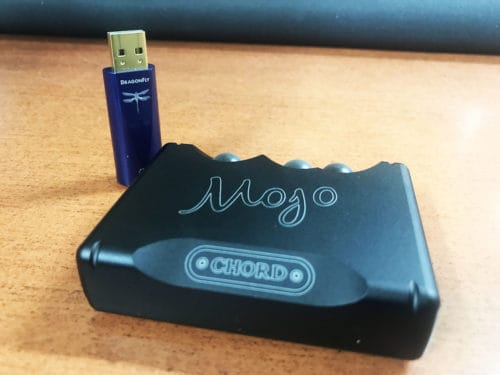
Specifications
| Audioquest Dragonfly Cobalt | Chord Mojo | |
|---|---|---|
| Supported Sample Rates | PCM up to 96 kHz, and MQA | PCM up to 768 kHz and DSD up to 256 |
| Output | 2.1 Vrms @ 10k ohms or higher | 35 mW @ 1 kHz, 600 ohms
720 mW @ 1 kHz, 8 ohms |
| Inputs | USB A | Micro USB (768 kHz/32 bit), Coaxial (768 kHz/32 bit), Optical/TOSLINK (9\96 kHz.24 bit) |
| DAC Chip | ESS ES9038W2M (minimum phase slow roll-off) | Chord Custom FPGA DAC chip |
| Dimensions | 12 mm (h) x 19 mm (w) x 57 mm (l) | 22 mm (h) x 60 mm (w) x 82 mm (l) |
| Price | $299 | $479 |
Compare the ranking of various headphones, earbuds and in-ear monitors using our tools.
Discuss this, and much more, over on our forum.
---MAJORHIFI may receive commissions from retail offers.


